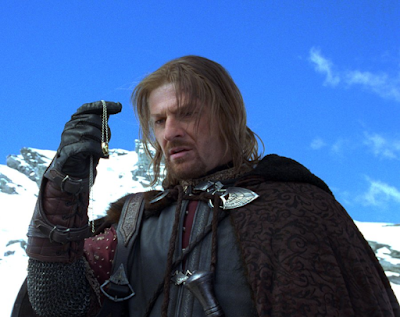The Ring of Barahir
Many who have watched the extended edition of the LOTR movies or have read the books will
remember hearing or seeing brief mentions of the “Ring of Barahir”. However, most don’t anything about it. Here we will see and discuss everything there is to know about this splendid piece of jewelry.
 |
| The Ring of Barahir as seen in the Lord of the Rings movies |
In the movie, the Ring is mentioned when Grima returns to Saruman in Isengard. He gives his report and mentions who was with Gandalf at the time. When he speaks about Aragorn he mentions that he looked like one of the Dúnedain Rangers and had a strange ring on his finger. Aragorn also consistently wears the ring throughout.
The Ring’s History
The ring has its origins way back into the First Age. Barahir, for whom the ring was named, was the father of Beren. He became the Lord of the house of Bëor after his brother’s death in the Dagor Bragollach, which is also known as The Battle of Sudden Flame. For an explanation of this battle see chapter 18, Of the Ruin of Beleriand and the Fall of Fingolfin in the Silmarillion. During the battle, Finrod, king of Nargothrond, became trapped by a wall of enemies in the Fen of Serech. He faced certain death when Barahir came to the rescue with his men and risked life and limb to save him.
Afterward, Finrod was so overcome with gratitude that he gave Barahir his ring which pictured the “badge of his house” and swore to be a loyal friend and always help him and his family if they ever were in need. After the battle, Finrod returned to Nargothrond and Barahir to the land of Dorthonion, which was now very dangerous. This was somewhat a rebellion since that land was under the control of Morgoth. Their condition became so bad that Barahir had to force his wife to leave with much of their people and seek refuge elsewhere. They became hunted outlaws who were slowly picked off one by one, without news or contact with anyone other than themselves.
Barahir’s son was Beren. When there were only thirteen men left in the band, they were all killed by treachery while Beren was away. When he returned and found them dead, he went after the orcs that killed him. Once he found them he killed the captain and took his father’s ring that they had stolen.
Later, in Beren and Lúthien, Beren used the ring to go safely to Nargothrond and ask for help from Finrod there. He soon found that Finrod had not forgotten what he had sworn and, although he thought that Beren’s mission was hopeless, he volunteered to come in order to fulfill his oath. During the course of the quest, Finrod died saving Beren’s life, and Beren went on to retake the Silmaril from the crown of Morgoth himself.
Heirloom of the kings of Arnor
Afterward, the Ring became an heirloom of Beren’s house, and went on to find its way down to the hands of Elendil and then to those of Isildur his son. The Ring of Barahir became the identifying mark of the kings of Arnor. In the fan-film “Born of Hope” which I highly recommend, Sauron searches for the heir of Isildur by looking for the ring. Although this has no basis on anything written by Tolkien (that I am aware of) it’s true that the Ring of Barahir would have been an identifying factor of the Kings of Arnor.
When Arvedui Last-king took refuge in Forochel he gave them his ring. Therefore, when he drowned soon after the ring wasn’t lost with him. His people must have ransomed the ring from the men of Forochel because it later says that the Ring of Barahir was kept in the house of Elrond for safekeeping where it eventually found its way into the hands of Aragorn.
What Did it Look Like?
The Ring looked like the badge of the house of Finarfin which is described as
Therefore, the Ring of Barahir as seen in the LOTR movies is largely inaccurate (see above for picture). Although in “Born of Hope” the ring is more accurate, it lacks the serpents upholding and devouring the crown.
Tolkien, J.R.R. The Return of the King. 1955. Del Rey. pp. 351-352. Date accessed
Jan 13, 2019.
Tolkien, J.R.R. The Silmarillion. 1977. Del Rey. Edited by Christopher Tolkien. Date accessed
Jan 13, 2019.



Comments
Post a Comment